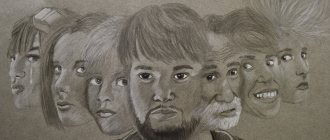Symptoms characteristic of hysterical psychopathy
People diagnosed with hysterical psychopathy shock others with their extravagance and excessive emotionality. If an ordinary person in stressful situations tries to calm down and pull himself together, then patients with the disorder begin to play to the public: they panic, imitate loss of consciousness or throw terrible hysterics with breaking dishes and threatening to kill themselves. They calm down only when they see compassion and willingness to help on the faces of those around them.
A person with histrionic psychopathy does not care about the feelings and emotions of their parents, spouse, or children. He is the center of the Universe, and the rest are created to worship and please, to make his life comfortable and happy. Hysterical personalities are easily offended by even minor offenses or words. They crave recognition and fame, and if they don’t find it, they become depressed or, conversely, enraged.
The movements of such people are somehow unnatural and exaggerated, their facial expressions are too active and feigned. They try to look majestic and aristocratic, but it turns out ridiculous and comical. Hysterical personalities are reminiscent of a king who came out naked in front of his subjects, but did not want to admit that he was naked. Such people will play their role to the last, until it turns out that the audience has long been disappointed and gone home. Then they go in search of the next victims, ready to listen to their long pathetic speeches and numerous complaints about this unjust world.
Symptoms
The main characteristics of histrionic personality disorder are emotional instability and the desire to attract attention by any means. A histrionic personality is a pronounced extrovert. The hysteroid feels out of place when he is on the periphery. To achieve his goal - attracting attention to himself, he is ready to use all methods. They include psychological provocations aimed at teasing, hooking the interlocutor or partner with something, or even outright lies or fantasies.
Another feature of a hysterical personality is an inferiority complex of one’s own sex. This property is especially characteristic of women. It is for this reason that the histrionic person seeks to conquer his partner. At the same time, even a close relationship with a partner does not destroy the inherent feeling of fear experienced in relation to a hystronic personality, the fear of close intimate relationships.
A frequently used means to attract the attention of others or your partner is appearance. If a histrionic person does not have natural beauty, then he creates an eccentric appearance for himself. Hysterical men tend to create a corresponding masculine image for themselves, for example, talk about non-existent travels and victories on the love front. And some prefer an image designed to elicit sympathy from others. A hysterical person is capable of resorting to simulating illness or even suicide - just to get attention.
Histrionic personalities seem to be very sensitive, they can throw a scandal over every little thing. They do not recognize halftones in the expression of feelings. This also applies to positive emotions, which hysterics tend to express exaggeratedly violently. The transition between positive and negative emotions can happen very quickly. At the same time, they are not capable of real deep feelings and emotions. They simply play this or that role, and their emotions are as natural as the emotions of an ordinary actor.
The tendency to exaggerate among hysteroids, in particular, is expressed in the fact that they usually exaggerate the level of their relationship with this or that person. For example, they tend to consider a casual acquaintance as their bosom friend, and imagine a fleeting acquaintance with a representative of the opposite sex as an ardent passion.
Hysteroids, despite their outward desire to be in the center of attention and seeming high opinion of themselves, are characterized by an inferiority complex. Subconsciously, they consider themselves inferior and weaker than others, and are also afraid of aggression.
Another disadvantage of hysterics is their inability to engage in purposeful activities, lack of perseverance, hard work and perseverance. Some hysterics strive to play the role of knowledgeable and experienced people, but their knowledge and skills in any field, upon close examination, almost always turn out to be superficial. Their goals and desires are also not constant. They tend to commit impulsive actions, to act under the influence of momentary impulses.
Histrionic personalities do not cope well with responsibilities that require punctuality, for example, taking into account money, planning. Despite the ability to manipulate people, hysterics themselves are easily suggestible and usually lack strong convictions. Hysteroids do not tolerate failures and mistakes well and therefore tend to avoid difficult situations for themselves, thereby depriving themselves of important life experience.
Even if histrionic personalities receive attention, their vanity is insatiable and requires more and more new incentives. Therefore, sooner or later a situation arises when the dissatisfaction accumulated in the hysteroid pours out on others in the form of aggression.
The tendency to constantly play out dramas, create scandals, self-centeredness, and the manifestation of insincere, false feelings, as you might guess, rather repels other people than attracts them. This is especially true for people who live for a long time with such a person. As a result, histrionic individuals have serious problems with their personal lives and with fulfilling their official duties. Moreover, most hysterics are talented people with abilities in the arts and organizational skills.
What do hysterical personalities look like?
Previously, it was believed that hysteroid psychopathy was predominantly a female disease. Recent studies have shown that men love attention and are prone to dramatic behavior just as much as girls. The disease according to ICD-10 is classified as class F60.4, or specific personality disorders.
Usually, the first symptoms of the problem appear in early childhood, when the child achieves what he wants with the help of screams and tears. Over time, the patient’s psychological state worsens, he masters the techniques of blackmail and various manipulations, and his emotions become superficial and change quickly. A minute ago a person could laugh and look happy with life, and a moment later he cries bitterly or is offendedly silent, although there are no visible reasons for such behavior.
Hysterical individuals are preoccupied with their own appearance. Their outfits are quite revealing and sexy, sometimes too much so. They buy bright things and unusual accessories, and use a lot of cosmetics. People with this disorder are constantly flirting or flirting with others. They need fans who will praise their beauty and sexuality. Some patients, out of desperation, rush into the arms of anyone who expresses a desire to make love to them. Such people may have 10 or more sexual partners throughout their lives.
Sometimes hysterical personality disorder turns a man impotent, and makes a woman frigid and asexual, so all they can do is flirt and enjoy the attention of the opposite sex.
People with such a problem instantly get excited about an idea and enthusiastically begin to bring it to life, but rather quickly lose interest and curtail their activities. They are easily suggestible and sometimes try to copy book characters or heroes from a popular film. Patients with hysterical psychopathy are constantly in search of new sensations, for the sake of which they are ready to do crazy and dangerous things.
Your psychologist. The work of a psychologist at school.
According to ICD-10, histrionic personality disorder (hereinafter referred to as IPD) is a personality disorder characterized by superficial and unstable excitability, a tendency to dramatize, theatricality, as well as exaggerated expression of emotions, suggestibility, egocentrism, self-indulgence, lack of attention to others, easy vulnerable feelings and a constant desire to have success and attention. Typically, this disorder affects approximately 2% of the general population and approximately 10-15% of patients in inpatient and outpatient mental health care settings. Basic personality traits may be inherited, while other traits may be due to a combination of genetics and environment, including childhood experiences.IRF is more common in women than in men. It occurs in approximately 1.8% of the general population (possibly due to cultural influences and mental health practitioner bias; men also show symptoms of IPD differently than women). Like most personality disorders, histrionic personality disorder typically begins in early youth. It is very rare for it to be diagnosed in childhood or adolescence because a child or adolescent is constantly developing, his personality changing and maturing. However, if it is diagnosed in a child or adolescent, symptoms must be present for at least 1 year. Thus, most diagnoses are made in early adulthood, with most people experiencing some of the most extreme symptoms being in their 40s and 50s. The intensity of IRL decreases with age.
In Western psychotherapeutic discourse, this disorder used to be called “hysterical disorder,” but today it is called “Histrionic personality disorder,” which can be translated rather as “Theatrical personality disorder.” One should also distinguish between IPD and hysteroidal accentuation of character (personality). Causes Today there is a lack of research on the causes of IPD.
However, although the causes of this disorder are not fully known, it is believed that IPD may have biological, cognitive, or social etiologies. Within the framework of the psychoanalytic direction, they talk about the reasons associated with human development at an early age. So, speaking about neurochemical or physiological causes, researchers note that patients with IPD have a highly sensitive noradrenergic system with mechanisms that cause the release of a neurotransmitter called norepinephrine. Neurotransmitters are biologically active chemicals that transmit electrical impulses from a nerve cell through the synaptic space between neurons in the brain. The tendency to overreact to rejection, common among patients with IPD, may be attributed to a disruption in a group of neurotransmitters called catecholamines (norepinephrine belongs to this group of neurotransmitters). The psychoanalytic interpretation of early psychoanalysts suggests that the genital (fifth or last) stage of psychosexual development is a determinant of IPD. However, more recent psychoanalysts believe that the oral phase is a much more important determinant of IPD. Most psychoanalysts agree that a traumatic childhood contributes to the development of this type of disorder. Some theorists suggest that more severe forms of IPD have their roots in a mother's disapproval of her child during childhood. Another part of psychoanalytic theory is defense mechanisms. According to Freud's theory, all people use defense mechanisms, but different people use different types of defense mechanisms. People with IPD vary in the severity of the maladaptive defense mechanisms they use. Patients with more severe cases of IPD may use defense mechanisms of repression, denial, and dissociation. For example, when patients with IPD use the defense mechanism of dissociation, they may show two or more faces. These persons exist in one person without integration. Patients with less severe cases of IPD tend to use defense mechanisms such as displacement and rationalization. Displacement occurs when the patient moves an impulse or feeling from the original object to another. For example, a person with IPD may feel angry at work because the director does not consider him the center of attention. The patient may direct his anger toward his wife rather than toward the director. Biosocial causes of IPD associated with learning are also identified. The biosocial model in psychology states that social and biological factors contribute to the development of individuality. Biosocial models suggest that people may acquire this disorder from inconsistent interpersonal reinforcement provided by parents. Proponents of biosocial learning models point out that people with IPD have simply learned to get what they want by attracting the attention of others. Among the sociocultural factors, the just identified cultures with high rates of IPD suggest social and cultural causes of IPD. For example, we are talking about cultures in which the free display of one's emotions is encouraged and highly valued. Finally, reasons related to personal characteristics. Researchers have found a connection between the age of patients with IPD and their behavior. Despite the fact that symptoms of IPD appear over a long period of time, theatrical character traits may change with age. For example, research shows that “seduction” is more often used by the young, rather than the elderly and old. In order to impress others, older adults with IPD may change their strategy from sexual seductiveness to paternal or maternal seductiveness. However, some other symptoms may become more severe as you age than when you were younger. Signs and symptoms According to ICD-10, this mental disorder is diagnosed when the general diagnostic criteria for personality disorder are met, plus three or more of the additional criteria: General criteria for personality disorder
| Signs of IRF, F60.4 | |
| A. marked disharmony in personality attitudes and behavior, usually involving several areas of functioning, such as affectivity, excitability, impulse control, perceptual and mental processes, and style of relating to other people; in different cultural conditions it may be necessary to develop special criteria regarding social norms; b. the chronic nature of an abnormal style of behavior that arose long ago and is not limited to episodes of mental illness; V. the abnormal behavior style is pervasive and distinctly disruptive to adaptation to a wide range of personal and social situations; d. the above-mentioned manifestations always arise in older childhood or adolescence and continue to exist in the period of maturity; e. the disorder causes significant personal distress, but this may only become apparent later in the course of time; That is, usually, but not always, the disorder is accompanied by a significant deterioration in professional and social productivity. |
|
Additional traits may include self-centeredness, self-indulgence, a constant desire to be recognized, being easily offended, and constant manipulative behavior to get one's needs met. The hysterical personality and the histrionic personality are included. According to the DSM-V, there are 8 symptoms that form diagnostic criteria for IPD: 1. Center of attention: the patient feels uncomfortable in situations where he is not the center of attention; Individuals with IPD feel victimized if the focus of attention shifts from them to another person. They will do whatever it takes to make sure they take center stage on stage and have everyone's eyes on them. It doesn't matter whether the attention is negative or positive. Even if other people feel negative emotions towards them, it is better than ignoring them. When attention wanes, they resort to a variety of antics to return it to themselves. These antics can be outrageous, mean-spirited, such as attacking a weaker person, or shouting inappropriately loudly in a restaurant. 2. Sexual seductiveness: interactions with others are often characterized by inappropriate seductiveness or provocative behavior; People with IPD often use sexuality for manipulative purposes. They are characterized by inappropriate flirting, overly revealing clothing, and sometimes even exhibitionism. Getting attention and getting what they want is the goal, and sexual behavior helps them achieve this. 3. Change of emotions: shows rapidly changing, shallow emotions; The emotions of people with IPD change like the weather and are just as unpredictable. At this moment they have “a holiday of the soul, a name day of the heart,” the next - they live “in the worst of possible worlds.” At times it may seem like they are two different people. In severe cases, patients may have IPD combined with multiple personality disorder. 4. Obsession with appearance: consistently uses one's appearance to attract attention; This is a common trait among all people with IPD, but women are especially obsessed with their physical appearance. Since they use sex as a manipulative weapon, having an attractive physical image is a necessity. Even when they look great, they are never satisfied and will always find a reason to complain or feel bad about their appearance. 5. Speech Style: The patient has an impressionistic and manipulative style of speech with a lack of attention to detail, generalizations, and a desire to please and impress; This is one of the most cunning manipulations. Individuals with IPD do everything they can to say what the other person wants to hear in order to manipulate them. It may be hard to notice at first glance, but there are problems with the content and context of the message. Their answers are often incongruent. For example, when they compliment someone, they often do not express their true feelings. They only say nice things to get the other person to do what they want. The conversation remains at a superficial level and rarely has much depth. 6. Dramatic Behavior: Demonstrates self-dramatization, theatricality, and exaggerated emotions; The term “Drama Queen” is a good one for this symptom. Despite the fact that it sounds in relation to women, it is just as suitable for men. Such exaggerated drama seems excessive and very funny for the average person. So, if they come across a tiny mouse, they squeal as if they had encountered a herd of mice the size of elephants. The same goes for the stories they tell. Everything was embellished much more than it really was. People with IPD focus on the negative, even when something amazing has happened. For example, if they win the lottery in the summer, they complain that it is too hot to go and collect their winnings. For them nothing is good enough. Everything is very boring and tiring, and generally a big burden for them. 7. High suggestibility: suggestible, that is, easily influenced by others or the situation; 8. Inaccurate perceptions of intimacy: Believes relationships are closer than they actually are. Since patients with IPD often treat other people superficially, having ephemeral relationships and many casual acquaintances, they overestimate the depth of relationships. So, the person they once met for five minutes suddenly becomes their best friend. This is especially the case if the person is famous. In their minds, everyone they meet is just a pawn in a game of chess. They tend to overestimate how close other people actually are to them because they are only concerned with getting attention. Individuals with IPD may have difficulty achieving emotional intimacy in romantic or sexual relationships. Without realizing it, they often play a role (such as "victim" or "princess") in their relationships with others. They may try to control their partner through emotional manipulation or seduction on one level, while on another level one can see the marked dependence of people with IPD on their partners. People with this disorder often have problems relating to same-sex friends because their sexually provocative interpersonal communication style can cause a threat to their friends' relationships. These individuals may also alienate their friends with demands for constant attention. They often become depressed and upset when they are not the center of attention. People with theatrical personality disorder crave novelty, stimulation and excitement, and tend to become bored in the routine of everyday life. These people are often intolerant or dissatisfied in situations involving delayed results, and their actions are often aimed at immediate gratification. Although they often initiate work or work on a new project with great enthusiasm, their interest quickly wanes. Such people believe that long-term relationships can be neglected in order to make room for the excitement that arises when meeting new people. Diagnosis Diagnosing IPD is difficult because the disorder can resemble many other disorders and because it usually co-occurs with other personality disorders. To diagnose IPD, ICD-10 and DSM-V criteria are used, as well as an individual medical history, the results of unstructured and semi-structured interviews. An essential criterion for making a diagnosis is also the fact that the symptoms of IPD must cause significant damage to the person. In addition, self-reports, psychometric tests (eg, MMPI-2, MCMI-III), and projective tests may be used for additional assessment. Scores on intelligence tests in people with IPD may indicate a lack of persistence in arithmetic or tasks that require concentration. The first signs of IPD: some psychoanalysts believe that the determinants of IPD are visible already in early childhood. The craving for attention and the demonstration of dramatic behavior for a person with IPD begins in youth, early adulthood. Signs can be diagnosed throughout life, but their number and intensity may decrease or increase with age. Some classification systems distinguish between different types of individuals with IPD: for example, those with an IPD emphasis on appeasement and those with IPD with an emphasis on hypocrisy. Patients with an emphasis on peace represent individuals with IPD, addiction (or more), and obsessive-compulsive disorder. Patients with an emphasis on hypocrisy have personality traits with IPD and antisocial disorder. Studies have shown that women with IPD are more likely to have problems with somatic behavior, and men with IPD are more likely to have problems with antisocial behavior. Dual, concomitant diagnoses are also common: IPD can be associated with alcoholism, somatic and conversion disorders, as well as major depressive disorder. Personality disorders such as borderline, narcissistic, dissocial, and dependent personality disorders can co-occur with IPD. Refining the diagnosis Distinctive diagnosis is the process of distinguishing one mental disorder from other similar disorders. For example, at times, it is difficult to differentiate between IPD and borderline personality disorder. Suicide attempts, identity confusion, and multiple chaotic relationships with others occur at lower rates, but do occur in people diagnosed with IPD. Another example of overlap may occur between IPD and dependent personality disorder. Patients with IPD and dependent personality disorder equally demonstrate high levels of dependency, but only dependent personality disorder is associated with high levels of self-attributed dependency needs. Please note that patients with IPD tend to be active and seductive, while people with dependent personality disorder tend to be submissive in their behavior. Treatment for IPD, like other personality disorders, may require several years of treatment and may last a lifetime. Some professionals believe that psychoanalytic therapy is the preferred treatment for IPD because it helps patients recognize their own feelings. Long-term psychodynamic therapy should target people with IPD who have underlying conflicts and help patients reduce their emotional reactivity. Psychotherapists work with such important topics for patients with IPD as closeness, intimacy and responsiveness, attention. People with IPD may experience difficulty with an intense desire to “crowd out” these topics by inertia. Cognitive behavioral therapy involves treatment aimed at reducing dysfunctional thoughts. Such thoughts include themes of inability to take care of oneself. Cognitive psychotherapy focuses on changing global, suggestible attitudes toward a more methodical, systematic, and structured understanding of problems. Cognitive-behavioral training involves complete relaxation of the patient, during which the ability to resist obsessive thoughts about inferiority and inability to cope with one’s life is emphasized. This therapy teaches patients with IPD to control intrusive thoughts, work on impulsive behavior, and develop skills that allow them to better solve problems. Behavior therapists use assertiveness training to help people with IPD learn to cope using their own resources. Behavior therapists use “response cost” to reduce overly dramatic behavior in these individuals. "Response costing" is a behavioral technique that involves separating a stimulus and a person's environment so that the response to the stimulus is secondary and significantly reduced compared to that immediately preceding the separation. Behavior therapy for IPD includes techniques such as modeling and behavioral rehearsal to teach patients to regulate their theatrical behavior. Group therapy encourages people with IPD to work on their interpersonal relationships. Psychodrama, or group role-playing, can help people with IPD practice solving problems they face in life and learn to reduce the display of overly dramatic behavior. Using role-playing, patients can explore interpersonal relationships and their outcomes to better understand the processes involved in different scenarios. Group therapists must control the group because people with IPD tend to dominate others. In family therapy, the therapist guides people with IPD to talk directly with other family members. Family therapy aims to encourage family members to indulge their own needs without supporting the theatrical behavior of the family member with IPD, who uses dramatic crises to keep the family cohesive and closely connected. Family therapists use behavioral rules to support assertive behavior instead of hysterics. To support the positive outcome of behavior, rather than indulging in hysteria, family therapists use behavioral rules. It can be said that drug treatment is not preferable for people with IPD unless other medical conditions contribute to it. For example, if IPD is accompanied by depression, the patient may be prescribed antidepressants. Drug treatment must be monitored and, if necessary, adjusted or discontinued to be appropriate and effective. Finally, alternative therapy may use practices such as meditation (to help relax and focus on one's own inner feelings) and hypnosis (to help people with IPD to distract themselves when they experience a fast heart rate or palpitations during periods of overly dramatic, emotional , and excitable behavior). In hypnosis, you can identify internal conflicts and work with them (hypnoanalysis). Prognosis The course of the disease in IRF manifests itself in different ways. As a rule, people with IPD often use medical (psychotherapeutic, psychiatric) help, but they usually do not continue psychotherapeutic treatment long enough to make changes in their personality. These people tend to set vague goals and move on to something more exciting. Minimal treatment for IPD can take one to three years and tends to take longer than treatment for disorders that are not personality disorders, such as anxiety or mood disorders. People with IPD with experience (mostly older people) show fewer signs. Some studies suggest that the difference between young and older adults may be attributed to older adults having less energy. Conclusions It can be noted that the manifestation of IPD arises at the intersection of the personal, individual manifestation of oneself by a person and the need for public recognition of the value of this personal manifestation. At first glance, this is a natural process of social competition, and so it is exactly until its manifestations begin to interfere with and stop other, parallel processes of social life. Simply put, until this person begins to interfere with others. Hysterical behavior is deconstructive. Hysteria is an ancient evolutionary mechanism of salvation in conditions of unpredictable or obviously fatal external threats. For example, being caught by a predator, the victim demonstrates hysterical behavior, thereby putting the predator into a stupor, and at the same time launching a chaotic, spontaneous process of exiting a catastrophic situation, which, perhaps, in the future, will be adopted. Thus, in relation to the treatment of IPD, a constructive method is the development and training of a set of clear and effective practices for resolving the social conflict that has arisen. It is important to understand that drug intervention in the process of social competition leads to personality degradation on a social level, and then on a personal level.
References 1. ICD-10 International statistical classification of diseases and related health problems. World Health Organization, Geneva. Class V. Mental and behavioral disorders 2. Diagnostic and Statistical Manual of Mental Disorders, Fifth Edition. Arlington, VA, American Psychiatric Association, 2013. 3. Bressert S. Histrionic Personality Disorder Symptoms. [Electronic resource] Psych Central – 2020. URL: https://psychcentral.com/disorders/histrionic-personality-disorder-symptoms/ (access date: 11.26.16) 4. Encyclopedia of Mental Disorders, Histrionic personality disorder [Electronic resource ] EMD – 2020. URL: 5. Bornstein, R. Dependent and histrionic personality disorders. In T. Milton, P. Blaney, R. Davis (Eds.), Oxford textbook of psychopathology, 1999. pp. 535-554 6. American Psychiatric Association. Diagnostic and statistical manual of mental disorders. (3rd ed.) Washington DC: Author. 1980 7. Stone, M. Borderline and histrionic personality disorders: A review. In M. Maj, H., S. Akiskal, J. E. Mezzich, A. Okasha (Eds.). Personality disorders, 2005. New York: Wiley. pp. 201-231 8. Markovitz, P. Pharmacotherapy, In. W. J. Livesley (Ed.), Handbook of personality disorders, 2001. New York: Guilford. pp. 475-493 9. Gunderson, J., Gabbard, G. (Eds.). Psychotherapy for personality disorders. Washington, DC: American Psychiatric Press. 2000. pp. 100-212 10. Sperry, L. Histrionic personality disorders (2nd ed., pp. 165-181). New York: Routledge, 2006. 11. Soloff, P. Somatic treatments. In J. M. Oldham, A. E. Skodol, D. S. Bender (Eds.), Textbook of personality disorders. Washington, DC: American Psychiatric Publishing, 2005. pp. 387-404 12. personality disorder. In L. Sperry (Ed.), Cognitive behavior therapy of DSM-IV-TR Source: Moscow State University named after M.V. Lomonosov Faculty of Sociology The work was carried out as part of the course “Social pathologies and personality typologies” Characteristics of hysterical personality disorder Completed by: student of group 601 Kuzmin Roman Gennadievich
Histrionic personality disorder: causes
Typically, symptoms of the problem develop in children who are idolized and overly loved from an early age. Parents try to give their offspring the best and realize their unfulfilled desires and goals with the help of their child. Girls are sent to dance schools and forced to perform in beauty contests or sports competitions. They carefully make the boy into a famous football or hockey player and force him to play the piano or other musical instrument. At the same time, parents shower the child with gifts, fulfill any whim and forbid practically nothing. In such families, children get used to the status of a star whom everyone worships. In the future, an adult transfers his egocentrism to others and refuses to recognize the fact that other people do not owe him anything and have the right to their own opinion.
In other situations, histrionic personality disorder is an attempt to get the attention of authoritarian parents. An overbearing mother or father who punishes any wrongdoing or prefers not to show their feelings makes the child think that no one needs him. Constant control makes children weak-willed and apathetic, and criticism reduces self-esteem. The child’s defense mechanism turns on and he begins to invent situations and reasons that can cause pity among others. A person gradually gets used to this pattern of behavior and it becomes difficult for him to give it up.
How to Recognize Early Symptoms of Bipolar Disorder
To detect unhealthy mood swings, you first need to find out whether you are experiencing emotional extremes - mania and depression.
7 Key Signs of Mania
- You experience elation and a feeling of happiness for long periods (several hours or more).
- Your need for sleep is reduced.
- You speak quickly. And so much so that those around you do not always understand, and you do not have time to formulate your thoughts. As a result, it is easier for you to communicate in instant messengers or via emails than to talk to people in person.
- You are an impulsive person: you act first, think later.
- You are easily distracted and jump from one thing to another. As a result, bottom line productivity often suffers.
- You are confident in your abilities. It seems to you that you are faster and smarter than most of those around you.
- You often exhibit risky behavior. For example, you agree to have sex with a stranger, buy something you can’t afford, or take part in spontaneous street races at traffic lights.
7 Key Signs of Depression
- You often experience prolonged (several hours or more) periods of unmotivated sadness and hopelessness.
- You become isolated in yourself. You find it difficult to come out of your shell. Therefore, you limit contact even with family and friends.
- You have lost interest in those things that used to really captivate you, and have not gained anything new in return.
- Your appetite has changed: it has sharply decreased or, on the contrary, you no longer control how much and what exactly you eat.
- You regularly feel tired and lack energy. And such periods continue for quite a long time.
- You have problems with memory, concentration and decision making.
- You sometimes think about suicide. Catch yourself thinking that life has lost its taste for you.
Manic-depressive psychosis is when you recognize yourself in almost all the situations described above. At some point in your life you clearly show signs of mania, at another you show symptoms of depression.
However, sometimes it happens that the symptoms of mania and depression manifest themselves simultaneously and you cannot understand which phase you are in. This condition is called mixed mood and is also one of the signs of bipolar disorder.
Causes of hysterical psychopathy in girls
In female children, hysterical personality disorder develops due to the constant suggestion that they are weaker and worse than men. Some families treat girls with disdain and even disgust, devaluing and humiliating them. The father, as a rule, behaves distantly, and the mother begins to treat her growing daughter as a potential competitor.
During adolescence, a girl realizes that she has a certain power that allows her to control men or seek their attention. She turns from a child into a young woman quite early and begins to play by adult rules. Boys and men become objects through which you can receive certain bonuses: money, beautiful clothes, housing and much more.
The opposite sex is simultaneously associated with danger and constant aggression, so its representatives need to be tamed and kept under control. The parents' stereotypical attitude towards the girl creates complexes in her, forcing her to consider herself not a full-fledged person, but simply a beautiful and sexy thing.
The girl gets acquainted early with cosmetics and revealing outfits, learns to flirt and seduce men. At the age of 14–15, he already has sex in order to compensate for the lack of parental love in this way. Some women realize their importance and worth as they age, gaining a chance at a normal life. The other girls continue to consider themselves third class, spending their resources searching for a worthy candidate who will defend and tolerate her dramatic behavior and eccentric actions.
Consequences of hysterical psychopathy
Some people use the symptoms of their disease to achieve success and career advancement. Sometimes histrionic personality disorder makes patients appear charming and charismatic. They make brilliant actors and speakers who adore public attention and are not afraid of performances. But more often the disorder interferes with a person, because only a few are able to endure emotional swings and constant manipulation on a daily basis.
Why does psychopathy need to be treated? People with this disease tend to defend their point of view to the last, even if it turns out to be wrong. They deceive themselves and those around them, which is why some patients become skilled swindlers, which is why they get into trouble with the law.
Women diagnosed with “hysterical psychopathy” often fall into the hands of abusers and tyrants. Selfishness and low self-esteem do not allow them to adequately evaluate a potential partner. Patients make the wrong choices, which cause them to suffer in their marriages and receive new psychological trauma.
The disease may be accompanied by physiological symptoms:
- hand tremors and nausea with excitement;
- numbness of the lower or upper extremities;
- attacks of suffocation and panic attacks;
- lack of sensitivity in certain parts of the body.
Despite selfishness and indifference, people with hysterical psychopathy are trusting and open, susceptible to suggestion, and therefore find themselves in unpleasant and dangerous situations. But the main reason for which you should consult a specialist is suicidal tendencies. Suicide attempts are one of the methods of manipulation, but the more often a person tries to cut veins or go out the window, the higher the chance that one day he will be able to finish what he started.
Where does bipolar disorder come from?
Mood swings are familiar to many and are not considered something out of the ordinary. This makes bipolar disorder quite difficult to diagnose. Nevertheless, scientists are coping with this more and more successfully. In 2005, for example, the Prevalence, Severity, and Comorbidity of Twelve-month DSM-IV Disorders in the National Comorbidity Survey Replication (NCS-R) found that about 5 million Americans suffer from manic-depressive illness in one form or another.
Bipolar disorder is more common in women than in men. Why is not known.
However, despite a large statistical sample, the exact causes of bipolar disorders have not yet been clarified. What is known is that:
- Manic-depressive psychosis can occur at any age. Although it most often appears in late adolescence and early adulthood.
- It may be caused by genetics. If one of your ancestors suffered from this disease, there is a risk that it will come knocking on your door.
- The disorder is associated with an imbalance of chemicals in the brain. Mainly serotonin.
- The trigger is sometimes severe stress or trauma.











